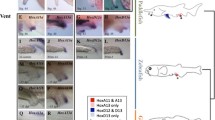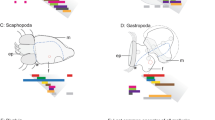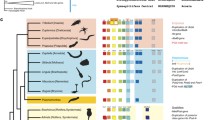Abstract
We have isolated the ten Hox genes from the pill millipede Glomeris marginata (Myriapoda:Diplopoda). All ten genes are expressed in characteristic Hox-gene-like expression patterns. The register of Hox gene expression borders is conserved and the expression profiles show that the anterior-most limb-bearing segment in arthropods (antennal/cheliceral segment) does not express any Hox gene, while the next segment (intercalary/second-antennal/premandibular/pedipalpal segment) does express Hox genes. The Hox expression patterns in this millipede thus support the conclusion that all arthropods possess a deuterocerebral segment. We find that there is an apparent posterior shift of Hox gene expression domains dorsally relative to their ventral patterns, indicating that the decoupling of dorsal and ventral segmentation is not restricted to the level of segment polarity genes but apparently includes the Hox genes. Although the mechanism for the decoupling of dorsal and ventral segmentation remains unsolved, the decoupling must be at a level higher in the hierarchy than that of the segment polarity and Hox genes. The expression patterns of Ultrabithorax and abdominal-A suggest a correlation between the function of these genes and the delayed outgrowth of posterior trunk appendages. This delay may be caused by an assumed repressor function of Ultrabithorax, which might partially repress the activation of the Distal-less gene. The Glomeris fushi tarazu gene is expressed in a Hox-like domain and in the developing central nervous system, but not in segmental stripes such as has been reported in another myriapod species, the centipede Lithobius. In contrast to the Lithobius fushi tarazu gene, there is no indication for a role in segment formation for the millipede fushi tarazu gene, suggesting that fushi tarazu first acquired its segmentation function in the lineage of the insects.













Similar content being viewed by others
References
Abzhanov A, Kaufman TC (1999) Homeotic genes and the arthropod head: Expression patterns of the labial, proboscipedia, and Deformed genes in crustaceans and insects. Proc Natl Acad Sci USA 96:10224–10229
Abzhanov A, Kaufman TC (2000a) Crustacean (malacostracan) Hox genes and the evolution of the arthropod trunk. Development 127:2239–2249
Abzhanov A, Kaufman TC (2000b) Embryonic expression patterns of the Hox genes of the crayfish Procambarus clarkii (Crustacea, Decapoda). Evol Dev 2:271–283
Abzhanov A, Popadic A, Kaufman TC (1999) Chelicerate Hox genes and the homology of arthropod segments. Evol Dev 1:77–89
Averof M, Akam M (1995) Hox genes and the diversification of the insect and crustacean body plans. Nature 376:420–423
Averof M, Patel NH (1997) Crustacean appendage evolution associated with changes in Hox gene expression. Nature 388:682–686
Brown SJ, Fellers JP, Shippy TD, Richardson EA, Maxwell M, Stuart JJ, Denell RE (2002) Sequence of the Tribolium castaneum homeotic complex. The region corresponding to the Drosophila melanogaster Antennapedia complex. Genetics 160:1067–1074
Carroll SB (1995) Homeotic genes and the evolution of arthropods and chordates. Nature 376:479–485
Carroll SB, Scott MP (1985) Localization of the fushi tarazu protein during Drosophila embryogenesis. Cell 43:47–58
Damen WGM (2002) fushi tarazu: a Hox gene changes its role. Bioessays 24:992–995
Damen WGM, Tautz D (1998) A hox class 3 orthologue from the spider Cupiennius salei is expressed in a Hox-gene-like fashion. Dev Genes Evol 208:586–590
Damen WGM, Tautz D (1999a) Comparative molecular embryology of arthropods: the expression of Hox genes in the spider Cupiennius salei. Invertebr Reprod Dev 36:203–209
Damen WGM, Tautz D (1999b) Abdominal-B expression in a spider suggests a general role for Abdominal-B in specifying the genital structure. J Exp Zool 285:85–91
Damen WGM, Hausdorf M, Seyfarth E-A, Tautz D (1998) A conserved mode of head segmentation in arthropods revealed by the expression pattern of Hox genes in a spider. Proc Natl Acad Sci USA 95:10665–10670
Damen WGM, Janssen R, Prpic N-M (2005) Pair rule gene orthologs in spider segmentation. Evol Dev 7:618–628
Denell RE, Hummels KR, Wakimoto BT, Kaufman TC (1981) Developmental studies of lethality associated with the Antennapedia gene complex in Drosophila melanogaster. Dev Biol 81:43–50
Dohle W (1964) Die Embryonalentwicklung von Glomeris marginata (Villers) im Vergleich zur Entwicklung anderer Diplopoden. Zool Jb Anat 81:241–310
Dohle W (1974) The segmentation of the germ band of Diplopoda compared with other classes of arthropods. Symp Zool Soc Lond 32:143–161
Duboule D, Dolle P (1989) The structural and functional organization of the murine HOX gene family resembles that of Drosophila homeotic genes. EMBO J 5:1497–1505
Enghoff H, Dohle W, Blower JG (1993) Anamorphosis in millipede (Diplopoda) — the present state of knowledge with some developmental and phylogenetic considerations. Zool J Linn Soc 109:103–234
Falciani F, Hausdorf B, Schröder R, Akam M, Tautz D, Denell R, Brown S (1996) Class 3 Hox genes in insects and the origin of zen. Proc Natl Acad Sci USA 93:8479–8484
Ferrier DE, Akam M (1996) Organization of the Hox gene cluster in the grasshopper, Schistocerca gregaria. Proc Natl Acad Sci USA 93:13024–13029
Foelix RF (1996) Biology of spiders, 2nd edn. Oxford University Press, New York
Frohnhöfer HG, Nüsslein-Volhard C (1986) Organization of anterior patterning the Drosophila embryo by the maternal gene bicoid. Nature 324:120–125
Galant R, Carroll SB (2002) Evolution of a transcriptional repression domain in an insect Hox protein. Nature 415:910–913
Gonzalez-Reyes A, Morata G (1990) The developmental effect of overexpressing a Ubx product in Drosophila embryos is dependent on its interactions with other homeotic products. Cell 61:515–522
Graham A, Papalopulu N, Krumlauf R (1989) The murine and Drosophila homeobox gene complexes have common features of organization and expression. Cell 5:367–378
Harzsch S, Wildt M, Battelle B, Waloszek D (2005) Immunohistochemical localization of neurotransmitters in the nervous system of larval Limulus polyphemus (Chelicerata, Xiphosura): evidence for a conserved protocerebral architecture in Euarthropoda. Arthropod Struct Dev 34:327–342
Hughes CL, Kaufman TC (2000) RNAi analysis of Deformed, proboscipedia and Sex combs reduced in the milkweed bug Oncopeltus fasciatus: novel roles for Hox genes in the hemipteran head. Development 127:3683–3694
Hughes CL, Kaufman TC (2002a) Exploring the myriapod body plan: expression patterns of the ten Hox genes in a centipede. Development 19:1225–1238
Hughes CL, Kaufman TC (2002b) Hox genes and the evolution of the arthropod body plan. Evol Dev 4:459–499
Hughes CL, Liu PZ, Kaufman TC (2004) Expression patterns of the rogue Hox genes Hox3/zen and fushi tarazu in the apterygote insect Thermobia domestica. Evol Dev 6:393–401
Janssen R, Prpic N-M, Damen WGM (2004) Gene expression suggests decoupled dorsal and ventral segmentation in the millipede Glomeris marginata (Myriapoda: Diplopoda). Dev Biol 268:89–104
Janssen R, Prpic N-M, Damen WGM (2006) A review of the correlation of tergites, sternites, and leg pairs in diplopods. Front Zool 3:2
Jürgens G, Wieschaus E, Nüsslein-Volhard C, Kluding H (1984) Mutations effecting the pattern of the larval cuticle in Drosophila melanogaster. II. Zygotic loci on the third chromosome. Wilhelm Roux Arch Dev Biol 193:283–295
Kaufman TC, Seeger MA, Olsen G (1990) Molecular and genetic organization of the Antennapedia gene complex of Drosophila melanogaster. Adv Genet 287:309–362
Lewis EB (1978) A gene complex controlling segmentation in Drosophila. Nature 276:565–570
Mann RS, Hogness DS (1990) Functional dissection of Ultrabithorax protein in D. melanogaster. Cell 60:597–610
Mann RS, (1997) Why are Itox genes clustered? Bioessays 19:661–664
McGinnis W, Krumlauf R (1992) Homeobox genes and axial patterning. Cell 68:283–302
Mittmann B, Scholtz G (2003) Development of the nervous system in the “head” of Limulus polyphemus (Chelicerata: Xiphosura): morphological evidence for a correspondence between the segments of the chelicerae and of the (first) antennae of Mandibulata. Dev Genes Evol 213:9–17
Mouchel-Vielh E, Blin M, Rigolot C, Deutsch JS (2002) Expression of a homologue of the fushi tarazu (ftz) gene in a cirripede crustacean. Evol Dev 4:76–85
Powers TP, Hogan J, Ke Z, Dymbrowski K, Wang X, Collins FH, Kaufman TC (2000) Characterization of the Hox cluster from the mosquito Anopheles gambiae (Diptera: Culicidae). Evol Dev 2:311–325
Prpic NM, Tautz D (2003) The expression of the proximodistal axis patterning genes Distal-less and dachshund in the appendages of Glomeris marginata (Myriapoda: Diplopoda) suggests a special role of these genes in patterning the head appendages. Dev Biol 260:97–112
Pultz MA, Diederich RJ, Cribbs DL, Kaufman TC (1988) The proboscipedia locus of the Antennapedia complex: a molecular and genetic analysis. Genes Dev 2:901–920
Ronshaugen M, McGinnis N, McGinnis W (2002) Hox protein mutation and macroevolution of the insect body plan. Nature 415:914–917
Rushlow C, Levine M (1990) Role of the zerknüllt gene in dorsal–ventral pattern formation in Drosophila. In: Wright TRF (ed) Advances in genetics, vol 27. Genetic regulatory hierarchies in development. Academic, San Diego
Sanchez-Herrero E, Vernos I, Marco R, Morata G (1985) Genetic organization of Drosophila bithorax complex. Nature 313:108–113
Sanetra M, Begemann G, Becker M-B, Meyer A (2005) Conservation and co-option in developmental programmes: the importance of homology relationships. Front Zool 2:15
Stauber M, Prell A, Schmidt-Ott U (2002) A single Hox3 gene with composite bicoid and zerknüllt expression characteristics in non-Cyclorrhaphan flies. Proc Natl Acad Sci USA 99:274–279
Telford MJ (2000) Evidence for the derivation of the Drosophila fushi tarazu gene from a Hox gene orthologous to lophotrochozoan Lox5. Curr Biol 10:253–349
Telford MJ, Thomas RH (1998a) Expression of homeobox genes shows chelicerate arthropods retain their deuterocerebral segment. Proc Natl Acad Sci USA 95:10671–10675
Telford MJ, Thomas RH (1998b) Of mites and zen: expression studies in a chelicerate arthropod confirm zen is a divergent Hox gene. Dev Genes Evol 208:591–594
van der Zee M, Berns N, Roth S (2005) Distinct functions of the Tribolium zerknüllt genes in serosa specification and dorsal closure. Curr Biol 15:624–636
Westheide W, Rieger R (eds) (1996) Spezielle Zoologie Teil 1: Einzeller und Wirbellose Tiere. Gustav Fischer Verlag, Stuttgart
Weygoldt (1985) Ontogeny of the arachnid central nervous system. In: Barth FG (ed) Neurobiology of arachnids. Springer, Berlin Heidelberg New York, pp 20–37
Acknowledgements
We would like to thank Jean Deutsch and Michel Veuille for the invitation to communicate our work on the Development and Phylogeny of Arthropods meeting in Paris (France) from September 23–24, 2005, and for the opportunity of publication in this journal. We thank Diethard Tautz for his continuous support of our work and Nikola-Michael Prpic for many discussions and critical reading of the manuscript. We also thank Hilary Dove for providing the Glomeris rapid amplification of cDNA ends template. This work was supported in part by the Deutsche Forschungsgemeinschaft via Sonderforschungsbereich 572 of the University of Cologne and by the European Union via the Marie Curie Research and Training Network ZOONET (MRTN-CT-2004-005624).
Author information
Authors and Affiliations
Corresponding author
Additional information
Communicated by guest editors Jean Deutsch and Gerhard Scholtz
Electronic supplementary material
Below is the link to the electronic supplementary material.
Fig. S1
Glomeris Hox gene sequences. a The partial homeodomain including the C-terminal flanking region of the G. marginata genes is aligned to other Hox gene orthologs of various arthropods, including the fruit fly D. melanogaster (Dm), the spider Cupiennius salei (Cs), and the centipede L. atkinsoni (La). Asterisks above the sequence indicate conserved amino acid positions. The lower case letters (elekef) in some of the Glomeris and Lithobius sequences indicate that these amino acids (aa) are derived from the primer sequences. A bold asterisk at the end of a sequence indicates the position of the stop codon, dots indicate that there are more sequences that are not included in the alignment. The dash (-) in the Gm-Abd-B sequence represents a gap that has been introduced to get a better alignment. b The complete homeodomain including the N-terminal flanking region of the G. marginata ftz gene is aligned to other ftz gene orthologs of other arthropods, a tardigrate, and an onychophoran. Conserved aa of the hexapeptide motif (YPWM) are highlighted in green, conserved aa of the YxD domain located between hexapeptide and homeodomain are shown in blue. Diagnostic aa within the homeodomain are highlighted in red. The dashes (-) represent gaps that have been introduced to get a better alignment. Aligned are the ftz sequences of the species as in a, and in addition, sequences of the centipede Ethmostigmus rubripes (Er), the mite Archegozetes longisetosus (Al), the cirripede Sacculina carcini (Sc), the beetle Tribolium castaneum (Tc), the grasshopper Schistocerca gregaria (Sg) (all arthropods), the onychophoran Acanthokara kaputensis (Ak), and the tardigrade Milnesium tardigradum (Mt) (GIF 11 kb)
Rights and permissions
About this article
Cite this article
Janssen, R., Damen, W.G.M. The ten Hox genes of the millipede Glomeris marginata . Dev Genes Evol 216, 451–465 (2006). https://doi.org/10.1007/s00427-006-0092-5
Received:
Accepted:
Published:
Issue Date:
DOI: https://doi.org/10.1007/s00427-006-0092-5




